Melies Part III:
More Magicians in the Films of Georges Melies
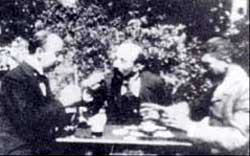 The very first film by Georges Melies recorded A Card Game (Une Paritic de cartes, 1896) which he & his family played at a table in their own back yard garden. Melies himself sits at the center of the composition enjoying with others mild merriment, drinking, smoking, dealing cards, reading a paper.
The very first film by Georges Melies recorded A Card Game (Une Paritic de cartes, 1896) which he & his family played at a table in their own back yard garden. Melies himself sits at the center of the composition enjoying with others mild merriment, drinking, smoking, dealing cards, reading a paper.
Long presumed lost, A Card Game turned up in in the 1990s in an archive in London. It's obviously an experiment & not an original work, for it closely copies A Game of Cards (Partie d'ecarte, 1896) which the Lumiere brothers made a few months earlier. And while Melies' pilot effort has the look of recording a natural event, it's actually fully staged.
At the time it was still regarded as "magic" merely that the pictures could be shown to move, & it was in great part Melies' lifelong interest in stage illusion that attracted him to the new medium of moving pictures. As the novelty of "mere" motion wore out, most of the pioneer filmmakers would turn to farce. But Melies had a wilder imagination.
As he owned & directed the Robert Houdin Theatre, which specialized in magic shows, it was a natural progression for Melies to leave the world of banal subjects such as reading the paper & playing cards, to recreating magic acts for film projection.
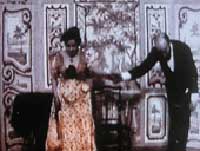 The Vanishing Lady; aka, The Conjuring of a Woman at the House of Robert Houdin (Escamotage d'une dame chez Robert-Houdin, 1896) is Georges Melies' earliest surviving pioneering film of trick photography, & his third earliest surviving film overall. The theme of the conjuror was one he would revisit throughout his film career. The Vanishing Lady; aka, The Conjuring of a Woman at the House of Robert Houdin (Escamotage d'une dame chez Robert-Houdin, 1896) is Georges Melies' earliest surviving pioneering film of trick photography, & his third earliest surviving film overall. The theme of the conjuror was one he would revisit throughout his film career.
Basically The Vanishing Lady recreates a stage act by the Victorian magician Buatier de Kolta. A woman vanishes from a chair, remateriales as a skeleton, then is restored to life. This is the very first use of the stop-camera trick, which makes it historically a film of considerable consequence, though not in itself all that interesting.
All too similar in nature is A Turn of the Century Illusionist (L'Impressioniste fin de siecle (1899). A magic act is again performed with Melies as the magician.
A disappearing trick uses a woman (Jehanne D'alcy, as in The Vanishing Lady) who is covered with a blanket & caused to vanish from her seat, & reappear in a barrel on a table. The magician then makes himself vanish & reappear in the barrel.
The reason the barrel is set up on a table is to make it clear the teleportation was not done with holes through the floor. This would be impressive with a live stage act, but is beside the point with trick photography. So there's not much to sustain wonder once the initial novelty of pictures moving wears thing.
Melies eventually learned his lesson, afterward striving for each film with magician or sorcerer, he would include events that a good stage magician couldn't do. To be sure, his best abjectly wonderful films would go well beyond faking a magic act with trick photography, but he loved magic acts so much personally he would never tire of using the theme of the conjurer from time to time.
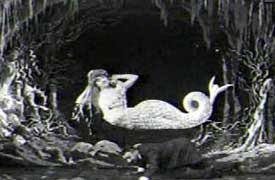 Many of Melies' films were based on actual stage or carnival magic, which he pushed to further extremes with camera tricks.
Many of Melies' films were based on actual stage or carnival magic, which he pushed to further extremes with camera tricks.
When I was a tot, my mom & step-dad owned a big-top, & I lived an itinerant life with the circus. One of my family's exhibits, done with mirrors, was "the lady in the fishbowl."
You could look in the glass aquarium & see plain as day a tiny woman sitting on a rock in the water, waving at the audience that tramped by in front of the bowl for a close-up look.
Melies with camera tricks instead of mirrors reduplicates the old carnival act in The Mermaid (La Sirene, 1904). We see Melies himself getting comfortable in a room with a window view, a hammock, & an aquarium. He tinkers with the aquarium for a while then takes up a cane, stands on a stool to use his walking cane as a fishing-rod, catches fish from his tophat, which he places in the aquarium.
He then turns himself into a white-whiskered gent in completely different costume, continuing to materialize live fish for the aquarium. He then turns back into the dark-suited gentleman & moves the aquarium exhibit to center stage, where it appears to grow to a much larger size, revealing a beautiful mermaid relaxing on her side as fish swim about her.
She then dematerializes & reappears outside the aquarium with legs, while the gentleman in dark suit turns into Neptune & seats himself in the giant aquarium with two more women materializing as his servants. It's certainly an imaginative little film at under four minutes.
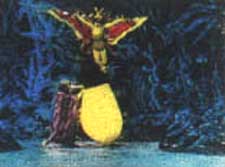 One of the most unusual & visually beautiful magic acts to be encountered in the cinema at any point in its history is The Brahmin & the Butterfly (La Chrysalide et le papillon d'or; aka, Brahmane et le papillon, 1901).
One of the most unusual & visually beautiful magic acts to be encountered in the cinema at any point in its history is The Brahmin & the Butterfly (La Chrysalide et le papillon d'or; aka, Brahmane et le papillon, 1901).
It was inspired by a trick performed in 1885 by French stage magician Buatier de Kolta (1845-1903). Kolta was a friend of Robert Houdin, whose theater & automata collection Melies owned & managed, & from whom Melies also took borrowed for his little film The Vanishing Lady.
The hand-tinted color is a feast for the eye, & the event seen is a feast for the imagination. Where conjuration ends & fairy tales begin is sometimes blurred in Melies' imagination.
The turbaned brahmin (Melies) plays a flute to beguile a giant caterpillar which seems even to fall in love with him. The caterpillar is an appealing puppet figure which the brahmin leaps upon & captures, putting it in a huge golden silk cocoon, from which a beautiful butterfly maiden arises, flying. At the close, the brahmin himself is transformed into a butterfly.
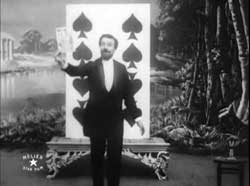 Melies again appears as a magician on stage in The Living Playing Cards (Les Cartes vivants, 1904) at about two & a half minutes length. Melies again appears as a magician on stage in The Living Playing Cards (Les Cartes vivants, 1904) at about two & a half minutes length.
He places a large blank canvas on a bench. Removing a single playing card from the pack, he makes it suddenly larger, then transfers the image of the nine of clubs onto the large blank canvas.
Taking another card, & placing a small smoking brazier momentarily in front of the enormous card.
He changes the Nine of Clubs into the Queen of Hearts, whom he then brings to life. Melies takes the Queen by the hand & helps her step down from the bench.
He then helps her back into the card where she ceases to be alive. Drawing another card he turns the giant canvas into the King of Spades, who leaps out of his own image tearing through the card like tissue, the canvas repairing itself behind him.
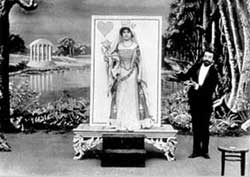 Melies exits stage left & the King of Spades throws off his white beard & king's robe, revealing that he is Melies. Melies exits stage left & the King of Spades throws off his white beard & king's robe, revealing that he is Melies.
Of Melies' many images of magicians in films lasting generally a scant two minutes, few are as good as The Living Playing Cards.
One of the best of the lesser examples, because of a great central image, is The Wonderful Living Fan; aka, The Marvelous Living Fan (Le Merveilleux eventail vivant, 1904).
The king of France seats himself to be entertained by a magician who has brought forth a large box which unfolds with aesthetic charm into an enormous lacy fan.
The fan's segments become beautiful women, & the round base becomes a starry globe. The maidens' costumes dissolve into alternate costumes.
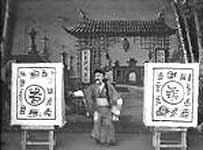 Searching for novel images to carry an idea that was wearing out, for Tchin-Chao: The Chinese Conjurer (Le Thaumaturge Chinois, 1904) assumes the same tricks would be nice to see again in an Asian context. Searching for novel images to carry an idea that was wearing out, for Tchin-Chao: The Chinese Conjurer (Le Thaumaturge Chinois, 1904) assumes the same tricks would be nice to see again in an Asian context.
Against a painted Chinese backdrop, a clown made up more or less to look Chinese, wearing however a Japanese kimono, begins to perform magic tricks. He turns one table into two & materializes paper lanterns. The lanters he turns into a dog, the dog into a geisha, with further manifestations.
Bringing out a pair of human-height boxes, teleportation tricks unfold. The geisha is finally wrapped into a bundle out of which come numerous chickens.
For The Enchanted Sedan-Chair (La Chaise a porteur enchantee, 1905) a courtly magician manifests a dandy from a glass box. The magician then obtains nice clothing from the same seemingly empty glass box, using them to dress a maniken, which he subsequently brings to life.
A palanquin or sedan-chair is carried center stage & the dandy climbs therein, being teleported to where the court lady has been seated, while she appears in the palanquin.
copyright © by Paghat the Ratgirl
|
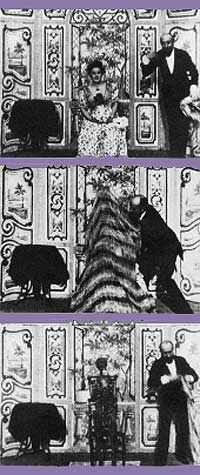





 Melies exits stage left & the King of Spades throws off his white beard & king's robe, revealing that he is Melies.
Melies exits stage left & the King of Spades throws off his white beard & king's robe, revealing that he is Melies. Searching for novel images to carry an idea that was wearing out, for Tchin-Chao: The Chinese Conjurer (Le Thaumaturge Chinois, 1904) assumes the same tricks would be nice to see again in an Asian context.
Searching for novel images to carry an idea that was wearing out, for Tchin-Chao: The Chinese Conjurer (Le Thaumaturge Chinois, 1904) assumes the same tricks would be nice to see again in an Asian context.